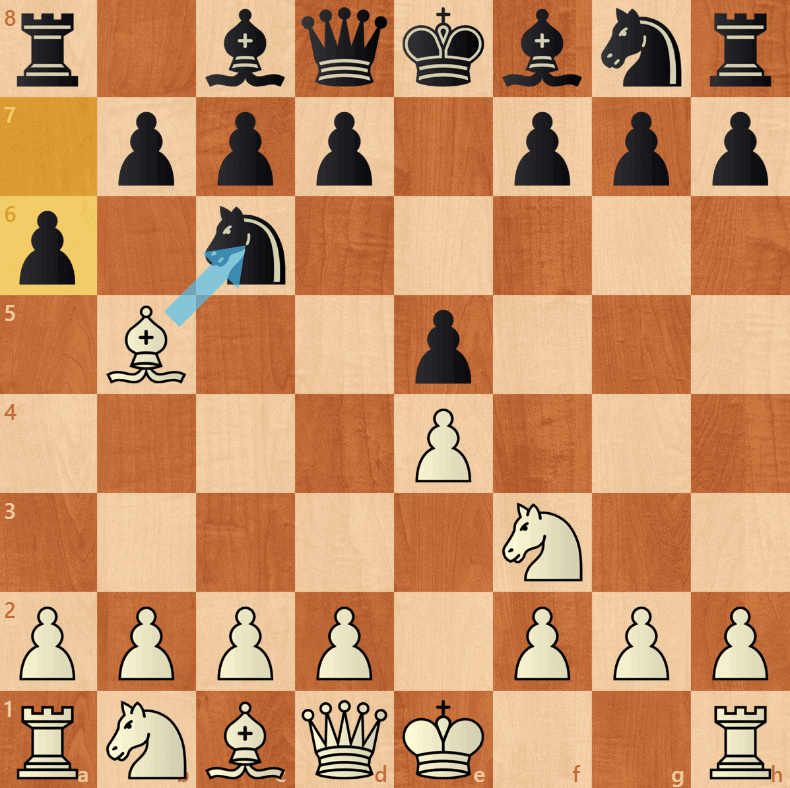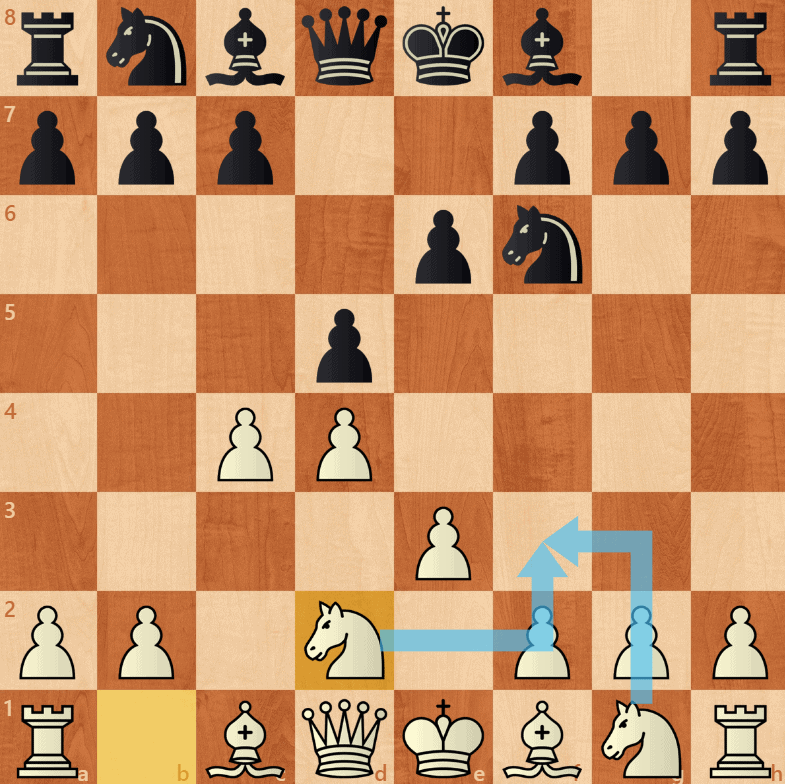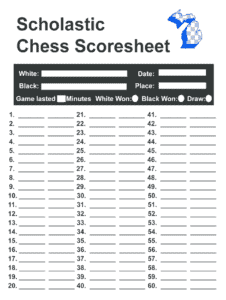Every square on a chessboard has its own name. Each piece has its own outline shape that is unique and distinguishable. The King, Queen, Bishop, Rook, Knight, and Pawn are all represented by a letter that is used when the moves are written down in chess move notation.
How to write down chess moves?
When you start to play chess games for real, you need to know how to write down your chess moves in algebraic notation on a score sheet. When you do this, you have to indicate which piece has moved to which square and also show extra information such as check and castling. Download printable chess scoresheets here
Naming Of The Squares
On the chessboard, each square can be identified by a distinctive coordinate, which is a letter followed by a number. The files (vertical square columns) from Queenside to the right of the Kingside are labeled a-to-h.
The ranks (horizontal square rows are numbered from 1 to 8, starting from the white side of the chessboard. Each square has a unique number and letter to identify its position. Below is an image of a chessboard that contains a grid system for writing down moves. (Every square is named according to its position on the board)
The ranks are named: 1, 2, 3, 4, 5, 6, 7, 8
The files are named: a, b, c, d, e, f, g, h

How To Identify The Chess Pieces: Chess Piece Notation
When moves are written down, each piece is identified by a letter, apart from the Pawn, which has no letter. For example, a Rook moving to d3 is written as Rd3, whereas a Pawn moving to d3 would just be written as d3.
Table Showing Notation of Chess Pieces
| Chess Piece | Universal Symbol | Notation |
| King |  | K |
| Queen |  | Q |
| Rook |  | R |
| Bishop |  | B |
| Knight |  | N |
| Pawn |  | (Noted by the square that it is on) (Can be sometimes represented as lowercase “p”) |
Other languages use different letters to represent chess pieces. For example, in French, players refer to the Bishop as “F” which in French is “Fou”. However, the universal symbols and shapes of the chess pieces remain the same.
Pawns are represented with lowercase letters mainly because distinguishing between them is not really necessary. This is because the pawn only moves one square at a time.
Chess Move Notation
To indicate a piece’s movement, the first uppercase letter is used, and then the square to which it moved. For example, Be5 means you moved the Bishop to the e5 square. Nf3 means that you moved your Knight to the f3 square. c5 means you moved a pawn to the c5 square (for pawns you do not need to use a lowercase p).
In our example below, the first two moves of this chess game are 1.e4 e5 2.Nf3 Nc6
Notation For Capturing Pieces
When a player makes a capture, they have to denote that on a score sheet with an “X” before describing the piece’s destination. Let’s say a player makes a capture Bxc6. This means that the Bishop captured a piece on the c6 square. Here is an example in the Ruy Lopez Opening:
White may capture the knight (Bxc6)

If a pawn captured a piece, the file from which it left is key to identifying the pawn’s location. For example, if the pawn on the e-file captures a piece on d5, this will be noted as exd5. Sometimes, players use the “:” sign in the same place where the “X” would go, or at the end of the notation. For example, either “B:e5” or “Be5:” is appropriate.
Capturing by En Passant
The word en passant is a French word that means “in passing”. If a pawn moves two squares on its first move, and by doing so ends up next to an opponent’s pawn, that pawn has the option of capturing as it passes by. This is only possible if the player acts immediately and captures the pawn via en passant. Otherwise, the move will expire, and en passant will not be available again.
Denoting en passant is pretty simple. The captures made by an en passant rule are indicated by specifying the pawn capture file with X and then the destination square.
Note, this square isn’t one of the captured pawns. After this, you can add the “e.p” suffix, which represents en passant. An example is exd6e.p. (open pgn from mobile view)
White has the option to en passant since the black pawn moved two squares to reach beside the white pawn on e4
Notation For Identical Moves and Pieces
If two or more identical chess pieces move towards the same square, the piece making the move is then uniquely identified by specifying the letter of the piece, and then the notations follow in ascending or descending order.
The notation depends on the:
- The file and their difference
- The rank of the departing piece, whether the files are the same, but have differing ranks; or
- Both the rank and file. This occurs in rare cases where two or more pawns have been promoted.
Let’s look at an example to better understand. With knights sitting on the g1 and d2 squares, which in both cases can move to f3, the move will be noted as Ngf3. If not, it can also be noted as Ndf3. Knights sitting on g5 and g1 can make moves, such as N1f3 or N5f3. As described above, “X” can be included to indicate capture.
Identical moves

Both the knight on g1 and the knight on d2 can reach f3. It’s therefore important that we indicate which of the knights is coming to f3 square.
Notation For Pawn Promotion
Once the pawn moves to the eighth rank, it is promoted to either a queen or another option. Once the piece has been promoted, it is then indicated at the end of the move.
For example, a pawn promoted to a queen is described as e8Q. Sometimes, the addition of an ‘equal to’ sign is also seen, but this represents the same promotion. For example, a pawn promotion could be recorded as e8(Q) or e8=Q.
These, however, are not FIDE standards.
Notation For Offering a Draw
In FIDE rules, an “=” sign is used to denote a draw on the score sheet right next to the piece move. However, this doesn’t fall under chess’ algebraic notation.
Notations for Castling
Special notations are used to represent castling. For Kingside castling, 0-0 is notated. 0-0-0 is used for Queenside casting.
Notation For Check and Checkmate

When the King is in check or being attacked we usually represent this with the “+” symbol. It can also be represented as an abbreviation “ch”
There are some cases when the King is being attacked twice (double check). The symbol used for a double check is “++” or dbl ch.
Notation For Game Completion
Once a game ends, if the white player wins it will be denoted 1-0, alternatively, 0-1 will be used for black victory. If the scoreboard shows ½ – ½ this indicates a draw. Other than these indications, no other symbol is used to describe a win or loss.
Sometimes, the scoreboard will list the information that states the black (or white) player resigned. This is simply a narrative to describe the scenario.
Table Showing Complete list of Chess Notations for Commentary and Analyzing Games
| Symbol Notation | Meaning | Symbol Notation | Meaning |
| ⁇ | Blunder | OL | Olympiad |
| ?! | Dubious move | jr | Junior event |
| !? | Interesting move | wom | Women’s event |
| ? | Bad move | mem | Memorial event |
| ! | Good move | rpd | Rapid play game |
| ∓ | Black is much better | corr | Correspondence game |
| ± | White is much better | 1-0 | The game end in a win for White |
| = | Equal position | 0-1 | The game ends in a win for Black |
| ∞ | The position is unclear | ½ – ½ | The game ends in a draw |
| # | Checkmate | (n) | The nth match game |
| + | Check | (D) | Diagram follows |
| ++ | Double Check | +
= | White is slightly better |
| !! | Brilliant move | =
+ | Black is slightly better |
| Ch | Championship | 0-0 | Kingside castle |
| Cht | Team Championship | 0-0-0 | Queenside castle |
| Wch | World Championship | ||
| Ct | Candidates event | ||
| IZ | Interzonal Event | ||
| Z | Zonal Event |
Final Verdict – How To Record Chess Moves In Algebraic Notation
By now, you understand that the chessboard is denoted with pairs of numbers and letters. Vertical files are lettered from “a” to “h” (from the left side of the white pieces, this is the queenside, all the way to the right).
Likewise, horizontal ranks are numbered from “1” to “8” (starting from the nearest end of the white piece side of the chessboard). With this lettering and numbering, it is easy to identify each square, and ranks can also be determined. For example, you should know that the white king starts from the e1 square. The black knight sits on b8, and it can move to either a6 or c6.
The importance of recording chess moves

In a formal tournament or competition, each player has the chance to record the moves they make on a scoresheet in chess notation. This helps settle any dispute or legal opposition. In case they violate any time delay methods or controls, they can make their claims by referring to the moves they have made and either draw on the fifty-move rule or repeat positions.
In matches held now, Algebraic Chess Notations are the most preferred way to record a game. Other recording systems are also available. However, in matches, the current rule says that each move has to accurately correspond to the chess notations before writing them down on paper or using any electronic device to make recordings. Before playing a game, each player has to first indicate an “=” sign on the scoreboard.
Time notations should also be accurately recorded on the scoreboard or the recording sheet. In case the player has less than the prescribed five minutes left to complete their moves, they will not be required to record unless an extra thirty-minute delay is added.
With a scoreboard and a recording sheet, players must refer to them each time. This means they have to see the moves the opponent player has made and then record their own as they proceed.
Frequently Asked Questions about Chess Notation

Are you allowed to stop recording chess moves?
There aren’t any severe penalties if you forget to record your move. You can simply burrow your opponent’s scoresheet to update yours. This should only be done in your turn. If your opponent is not recording the moves, it’s your responsibility to summon the arbiter and explain to him the situation. There should be no instances where the clock is paused so that one player can write down the moves.
Players are encouraged to write down their moves each time they make a move. This helps to settle any dispute or legal opposition. The arbiter can use the score sheets if one player decides to make a claim. All in all, you are not allowed to stop recording chess moves on your scoresheet. However, there is one exception:
When Can You Stop Recording Chess moves?
You should stop recording chess moves when you’re down to your last 5 minutes on the clock. It’s very common to stop writing when you have to blitz out the last stages of the game. Otherwise, you are still required to record.
How important are Scoresheets in Chess?
Recording your moves on a scoresheet not only helps to settle disputes and claims but can be used to help you analyze your own games. You only get stronger by analyzing your games from your scoresheet, so it makes sense to record.
If players did not record their games, we wouldn’t have many Grandmasters. Players become stronger by analyzing high-quality chess games from databases such as Chessbase. There would be no helpful chess articles, books, software, and games to learn from or draw insights from if stronger players did not record their chess games.
How to fill out a Chess scoresheet?
To record your chess moves, it is important to keep a score sheet, especially in tournaments and matches. Usually, these are distributed to players at the start of every round. However, most players prefer to record their individual scores in scorebooks. At the top of every scoresheet you are required to fill out your:
- Name
- Age
- Color (Black or White chess pieces)
- Board
- Round
- Result (Win, Draw, or Loss)
- Signature ( Sign your name)
At the end of every game, both you and your opponent should write your signature on both scoresheets as proof.
Related Post: How to read stockfish chess engine?






